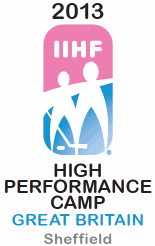SHEFFIELD – Summer’s in full swing, but in an English city where the Stanley Cup was forged, girls from all across the globe are hitting the ice at the 2013 IIHF Women’s High Performance Camp, learning how to take the next step towards becoming elite athletes.
Over 180 Under-18 female participants from 18 nations will meet this week in Sheffield, U.K. for the camp. They will interact with a full support team ranging from on-ice coaches to strength trainers to nutritionists, all brought together to provide resources for these Olympic hopefuls to create the right environment for success on the international stage.
The camp, now in its third year, has become the flagship program in the IIHF’s efforts to narrow the gap in women’s hockey between North America and the rest of the world. The theme for the 2013 HPC is “From Sochi to PyeongChang” which is the road many of these young athletes are hoping to take in order to reach the 2018 Olympics.
With this in mind, the camp’s purpose is to provide one-week example of what an athlete needs to do and focus on to become an elite female hockey player.
“This camp will hopefully be the impact step that you can take to be playing seven years from now,” said camp director Darryl Easson when speaking to the campers. “Obviously it’s important to have fun, but also to work hard while you’re here and make the most out of this opportunity.”
Easson noted that with so many girls from the same age group coming in from many different nations, the odds were good that some of these campers could be playing against each other in PyeongChang 2018.
“Some of you might be in Sochi, others will be aiming for Korea, but either way there’s a good chance you will see each other on the ice. That’s the nature of hockey, it’s a small family but a strong family because we work together,” he said.
In the spirit of cooperation the top two women’s hockey nations, Canada and the United States, contribute heavily to the camp each year by supplying coaches and trainers to help the girls in their development. Mel Davidson, former Team Canada hockey coach and veteran of the camp, marvelled at the camp’s growth in just three years’ time.
“The real success is seeing how many of the staff members return each year, and the ones that we run into over the whole year are continually asking about getting involved and bringing in their own people to help," said Davidson. "The players too are always excited, the word is out now and people want to come…I wish we had it when I coached!”
The campers arrived in Sheffield on Sunday and gathered at Sheffield Arena in the evening for introductions and go over the first two camp programs: an Introduction to Fitness Testing and the Path of a Champion Panel. The panel included four Olympic ice hockey players: Isabelle Chartrand (CAN), Carla Macleod (CAN), Tehri Mertanen (FIN), and Suzanna Tomcikova (SVK).
The girls got an additional surprise with a late addition to the panel: British skeleton world champion Shelley Rudman, who is training in Sheffield and agreed to stop by and speak with the girls.
“I thought it was a really good idea,” said Rudman. “I find that this point in a female’s life, right around when they’re finishing school or they’re just on the cusp of their international careers is when you get the highest dropout rate, so it’s a really crucial point to keep them involved in their sport.”
While the first two high performance camps took place in hockey centres like Slovakia, and Finland, the city of Sheffield would seem like an unusual choice for a hockey camp. But the city, home to the Elite Ice Hockey League’s Sheffield Steelers, boasts a modern ice rink and two practice rinks nearby, along with many fitness facilities within the complex surrounding the Steelers’ Motorpoint Stadium.
“The facilities here are very, very good, we’ve had a lot of great cooperation from the people here, and those really are the only two things you need,” said Easson. “We’ve got quite a few British players as well who missed out last year that have now been able to come in thanks to the camp being so close.”
Not to mention also that hockey’s holy grail, the Stanley Cup, was forged in a Sheffield foundry, as a punch bowl that was purchased by Lord Stanley Preston (a copy of it now comprises the top part of the modern Cup), and is presently on display at the Hockey Hall of Fame in Toronto, Ontario.
Beginning on Monday, the camp will split players from all countries up by position, then later divide them into six rosters, each consisting of 15 skaters and two goalies. Teams will be on the ice twice a day, including three games over the course of camp, dryland training, fitness testing and classroom sessions.
ADAM STEISS
|







